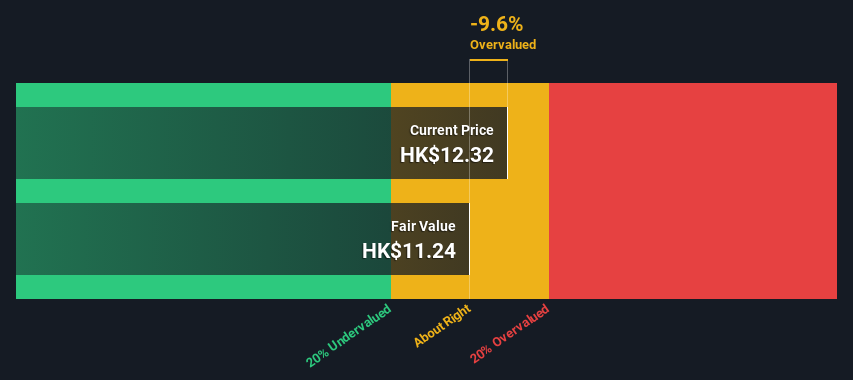Fair value estimate of China Merchants Port Holdings Company Limited (HKG:144)

Key findings
- The estimated fair value of China Merchants Port Holdings is HK$11.24 based on 2-step free cash flow to equity
- The current share price of HK$12.32 suggests that China Merchants Port Holdings may be trading close to its fair value
- The analyst price target of HK$13.11 for 144 is 17% above our fair value estimate
Does China Merchants Port Holdings Company Limited (HKG:144)’s share price in July reflect its actual value? Today we will estimate the stock’s intrinsic value by projecting its future cash flows and then discounting those to today’s value. One way to do this is by applying the Discounted Cash Flow (DCF) model. Before you think you can’t understand it, just keep reading! It’s actually a lot less complex than you think.
Companies can be valued in many ways, so we want to point out that a DCF is not perfect for every situation. If you want to learn more about discounted cash flow, you can read the basics of this calculation in detail in Simply Wall St’s analysis model.
Check out our latest analysis for China Merchants Port Holdings
The model
We use what is called a 2-stage model, which simply means that we have two different growth periods for the company’s cash flows. Generally speaking, the first stage is one of higher growth, and the second stage is one of lower growth. First, we need to get estimates for the next ten years of cash flows. Where possible, we use analyst estimates, but when these aren’t available, we extrapolate the previous free cash flow (FCF) from the last estimate or reported value. We assume that companies with shrinking free cash flow will slow their rate of shrinkage, and that companies with growing free cash flow will slow their growth rate, over this period. We do this to take into account that growth tends to slow more in the early years than in later years.
A DCF is all about the idea that a dollar in the future is worth less than a dollar today. So we discount the value of these future cash flows to their estimated value in today’s dollars:
Estimation of free cash flow (FCF) over 10 years
| 2025 | 2026 | 2027 | 2028 | 2029 | 2030 | 2031 | 2032 | 2033 | 2034 | |
| Leveraged FCF (HK$ million) | HK$5.23 billion | HK$5.47 billion | HK$5.29 billion | HK$5.20 billion | HK$5.18 billion | HK$5.19 billion | HK$5.24 billion | HK$5.30 billion | HK$5.38 billion | HK$5.48 billion |
| Source of growth rate estimate | Analyst x2 | Analyst x2 | Estimated @ -3.22% | Estimated -1.61% | Estimated -0.48% | Estimated 0.31% | Estimated at 0.86% | Estimated at 1.25% | Estimated at 1.52% | Estimated at 1.71% |
| Present value (HK$, million) discounted at 12% | HK$4.7,000 | HK$4.3,000 | HK$3.7 thousand | HK$3.3 thousand | HK$2.9 thousand | HK$2.6 thousand | HK$2.3 thousand | HK$2,1000 | HK$1.9 thousand | HK$1.7 thousand |
(“Est” = FCF growth rate, estimated by Simply Wall St)
Present value of 10-year cash flow (PVCF) = HK$30 billion
After calculating the present value of future cash flows in the first 10-year period, we need to calculate the terminal value that takes into account all future cash flows after the first period. The Gordon growth formula is used to calculate the terminal value at a future annual growth rate equal to the 5-year average of the 10-year Treasury yield of 2.2%. We discount the terminal cash flows to today’s value using a cost of equity of 12%.
Final value (TV)= FCF2034 × (1 + g) ÷ (r – g) = HK$5.5 billion × (1 + 2.2%) ÷ (12% – 2.2%) = HK$56 billion
Present value of terminal value (PVTV)= TV / (1 + r)10= HK$56 billion ÷ (1 + 12%)10= HK$18 billion
The total value or equity value is then the sum of the present value of future cash flows, which in this case is HK$47 billion. To get the intrinsic value per share, we divide this by the total number of shares outstanding. Relative to the current share price of HK$12.3, the company appears roughly fairly valued at the time of writing. However, keep in mind that this is only an approximate valuation and as with any complex formula, where there’s garbage in, there’s garbage out.

The assumptions
The above calculation relies heavily on two assumptions. The first is the discount rate and the other is the cash flows. You don’t have to agree with these inputs, I recommend repeating the calculations yourself and playing with them. DCF also doesn’t take into account the possible cyclicality of an industry or a company’s future capital needs and therefore doesn’t provide a complete picture of a company’s potential performance. Since we are considering China Merchants Port Holdings as potential shareholders, the cost of equity is used as the discount rate rather than the cost of capital (or weighted average cost of capital, WACC) which takes debt into account. In this calculation, we used 12% which is based on a leveraged beta of 1.837. Beta is a measure of a stock’s volatility relative to the overall market. We get our beta from the industry average beta of globally comparable companies with an imposed limit of between 0.8 and 2.0 which is a reasonable range for a stable company.
SWOT Analysis for China Merchants Port Holdings
- The ratio of net debt to equity is below 40%.
- Dividends are covered by earnings and cash flows.
- Revenues have declined over the past year.
- Interest payments on debt are not well covered.
- Compared to the top 25% of dividend payers in the infrastructure market, the dividend is low.
- Last year there was a dilution of shareholders’ shares.
- Annual revenues are expected to increase over the next three years.
- Good value based on the P/E ratio compared to the estimated fair P/E ratio.
- The debts cannot be adequately covered by the operating cash flow.
- Annual earnings growth is forecast to be slower than in the Hong Kong market.
Next Steps:
Although the DCF calculation is important, ideally it should not be the only analysis you look at for a company. It is not possible to get a foolproof valuation using a DCF model. Instead, the best use of a DCF model is to test certain assumptions and theories to see if they would lead to an undervaluation or overvaluation of the company. For example, making a small adjustment to the terminal value growth rate can dramatically change the overall result. For China Merchants Port Holdings, there are three key factors you should evaluate:
- Risks: For example, we found 2 warning signs for China Merchants Port Holdings that you should know before investing here.
- Future income: How does 144’s growth rate compare to its peers and the overall market? Learn more about analyst consensus numbers for the coming years by using our free chart of analyst growth expectations.
- Other high-quality alternatives: Like a good all-rounder? Explore our interactive list of high-quality stocks to get a sense of what else you might be missing out on!
PS. The Simply Wall St app runs a discounted cash flow valuation for every stock on the SEHK every day. If you want to find the calculation for other stocks, just search here.
Valuation is complex, but we help simplify it.
Find out if Port investments of Chinese traders may be over- or undervalued by checking our comprehensive analysis which includes Fair value estimates, risks and warnings, dividends, insider transactions and financial health.
View free analysis
Do you have feedback on this article? Are you concerned about the content? Get in touch directly from us. Alternatively, send an email to editorial-team (at) simplywallst.com.
This Simply Wall St article is of a general nature. We comment solely on historical data and analyst forecasts, using an unbiased methodology. Our articles do not constitute financial advice. It is not a recommendation to buy or sell any stock and does not take into account your objectives or financial situation. Our goal is to provide you with long-term analysis based on fundamental data. Note that our analysis may not take into account the latest price-sensitive company announcements or qualitative materials. Simply Wall St does not hold any of the stocks mentioned.
Valuation is complex, but we help simplify it.
Find out if Port investments of Chinese traders may be over- or undervalued by checking our comprehensive analysis which includes Fair value estimates, risks and warnings, dividends, insider transactions and financial health.
View free analysis
Do you have feedback on this article? Are you interested in the content? Contact us directly. Alternatively, send an email to [email protected]


